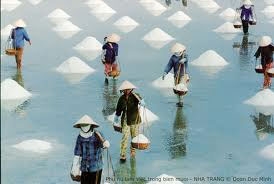Answer to salt sector’s bitter question
 |
| illustration photo |
>> Firms weep with salty tears
>> Rubbing salt into the wound
The local salt industry has a glut of edible salt, while it is critically short of industrial salt. Does that paradox come from the fact that the salt fields are in private hands with no effective state management tools?
Chinais the world’s leading salt producer, however, salt production and trading in this country is held by the state. In Vietnam, the fields producing industrial salt are small in both size and number and were formerly held by the state. However, they were all sold and are currently managed by private trading households and firms so that it would be impossible to ask the field owners to just produce industrial salt but not edible salt. Lack of industrial salt is then inevitable. To address the situation, it is crucial to set up the Vietnam Salt Association to correct the behaviour of different groups of interest.
How critical are industrial salt shortages?
Vietnamis often short of industrial salt. In 2010, industrial salt output accounted for around 21 per cent of total salt production, tantamount to 250,000 tonnes with the remaining 79 per cent offset by edible salt, equal to 932,000 tonnes. With around 86 million residents, Vietnam would need at most 500,000 tonnes of edible salt only.
In fact, most of salt resulted from manual production could not be used as a material for the chemical industry.
Besides, industrial salt fields mostly in three southcentral provinces of Ninh Thuan, Binh Thuan and Khanh Hoa are churning out not only industrial salt. Therefore, actual industrial salt output could be even lower than the estimated 250,000 tonnes in 2010.
Assuming a 200,000 tonne per year soda-water production plant came online in the central region in the coming period, the region’s total industrial salt production would not be enough to service this plant alone.
Our branch needs around 10,000 tonnes of industrial salt for producing quality refined salt to feed Hanoi’s market, but we could only buy 2,000 tonnes in the year to date though we placed orders right in early year. We hope we would buy another 2,000 tonnes of this salt in later months of 2011 to keep our factory running.
Is it possible to turn redundant edible salt into industrial salt?
Stockpiled salt is often of low quality and positioned in rural and remote areas. Part of the salt can be made into industrial salt if we apply specific cleansing techniques to remove mixtures. However, the production cost could be pushed up remarkably which would hardly be acceptable by consumers. The salt inventory can be sold to businesses for using as edible salt or for export if they are procured in large quantity and further processed to improve quality.
What the stars mean:
★ Poor ★ ★ Promising ★★★ Good ★★★★ Very good ★★★★★ Exceptional
Related Contents
Latest News
More News
- Kolon signs $48 million airbag supply deal with Autoliv (December 15, 2025 | 18:14)
- National Assembly approves Vinh–Thanh Thuy expressway project (December 15, 2025 | 18:02)
- Quang Tri green-lights $1.59 billion LNG-fired power project (December 15, 2025 | 17:59)
- Stress laid on high-quality FDI inflows (December 15, 2025 | 11:00)
- Can Tho utilises its growth advantages (December 15, 2025 | 09:09)
- Ca Mau unlocking potential to shape a more sustainable future (December 15, 2025 | 09:02)
- Major projects to be inaugurated nationwide (December 15, 2025 | 08:00)
- MoF workshop highlights mounting concerns over ODA on-lending costs (December 12, 2025 | 16:05)
- National Assembly approves pilot mechanisms to accelerate major projects in Hanoi (December 12, 2025 | 11:29)
- Legislation gives government flexibility for loan guarantees (December 11, 2025 | 18:04)

 Tag:
Tag:






















 Mobile Version
Mobile Version